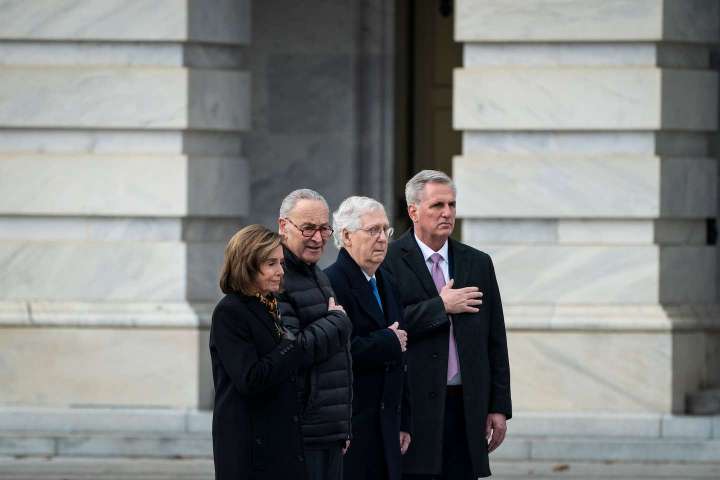It appears unlikely that Democrats will maintain control of all three levers of lawmaking power after the 2022 elections, with their razor-thin majorities in both the House and Senate severely endangered.
Biden’s summer blitz reinforces how vital a small number of voters can be

And much of it is thanks, apparently, to about 14,000 people in Georgia.
The story of the first half of Biden’s first term is an increasingly familiar one in American politics: Relatively few votes decide whether one party or the other has the power to make major changes. Shift a few votes here or there — such as depriving Democrats of a Senate seat in Georgia in the 2020 elections — and we have a very different political reality on the Supreme Court, taxes, health care, stimulus spending and now, perhaps to a lesser extent, guns and climate change.
As Democrats do now, Republicans controlled all three levers of power for the first two years of Donald Trump’s presidency, and they controlled the Senate for all four years. This allowed them to pass Trump’s 2017 tax cuts and install three Supreme Court justices, giving conservatives a 6-3 majority on the court — alongside, of course, Trump’s many far-reaching executive orders.
How close were we to a very different reality? Trump won the three decisive states in the 2016 election each by less than 0.8 percentage points. Fewer than 80,000 voters in Michigan, Pennsylvania and Wisconsin gave us President Donald Trump rather than President Hillary Clinton. (Exit polls suggest that these 80,000 people might well have swung the race at the 11th hour.)
The most significant practical policy impact of that — setting aside the more diffuse effects of Trump on our body politic — appears to be on the Supreme Court. Senate Republicans left a vacancy for him by refusing to hold hearings for almost all of 2016, and then the retirement of moderate Justice Anthony M. Kennedy and death of Ruth Bader Ginsburg gave him two more — with the latter two filled by very tight margins.
Were Clinton to have won in 2016? It’s unclear a GOP-controlled Senate would have confirmed her Supreme Court nominees, given how things are these days. But keeping the seat vacant for four years of a Clinton presidency would’ve been significantly more difficult than it was for the 11 months after Antonin Scalia’s death, when Republicans argued that voters should pick the president who got to fill the seat. It seems far less likely that Kennedy would’ve retired under Clinton, since justices tend to time their retirements to allow the party that selected them to fill the vacancy. What’s clear is that we wouldn’t have a 6-3 conservative majority.
But that hypothetical also shows how this dynamic works both ways; it isn’t just Democrats who can lay claim to the dynamic in which a small number of votes have massive implications.
The tax cuts Trump championed certainly wouldn’t have even been proposed in that timeline. But consider Trump’s other monumental first-term legislative effort: repealing Obamacare. This was killed off by the thumb of John McCain, falling one vote shy in the Senate. But Republicans in 2016 were about 1,000 New Hampshire votes shy of another Senate vote, when then-Gov. Maggie Hassan (D) defeated Sen. Kelly Ayotte (R-N.H.) by that margin. That doesn’t mean the “skinny repeal” of Obamacare would’ve been signed into law — there remained major hurdles in reconciling differences between the Senate bill and one that passed very narrowly in the House — but those 1,000 votes surely loomed large.
If it was fewer than 80,000 votes that gave Republicans complete control of Washington in 2016, it was arguably 14,000 that proved the turning point in giving it back to Democrats in 2020. That’s the margin by which then-Sen. David Perdue (R-Ga.) fell short of an outright majority (he got 49.73 percent) on Election Day, meaning he faced a runoff. He and fellow Georgia Sen. Kelly Loeffler (R-Ga.) then both lost their runoffs in January, giving Democrats an effective 50-50 majority and the trifecta.
So close are Democrats’ majorities in the House and Senate that you could’ve potentially handed Republicans the presidency, the House and the Senate in the 2016 election by flipping 90,000 votes in the right places.
But those 14,000 votes have now proved huge. Republicans made clear they had very little appetite for such a large pandemic stimulus package, and they surely wouldn’t have passed anything like the climate and health-care bill that just made its way through the Senate; they voted in unison against both. Supreme Court Justice Stephen G. Breyer’s retirement and replacement with a far-younger liberal justice would’ve been less likely for reasons noted above. (And indeed, both Trump and Biden also rapidly filled vacancies for lower courts in ways that wouldn’t have happened without trifectas.) It also seems very unlikely a Senate Majority Leader Mitch McConnell (R-Ky.) would ever bring up same-sex marriage for a vote as Democrats plan to next month, even as Republicans might provide the necessary votes to overcome a filibuster.
About the only conceivable signature pieces of legislation that might have passed in a GOP-controlled Senate under a President Biden would be a bipartisan infrastructure bill and, perhaps, a gun bill after the tragedy in Uvalde, Tex., both of which got enough GOP votes in the Senate, including McConnell’s. But again, it’s not clear anything like what passed would even have been brought to a vote.
We’re a closely divided and polarized country, meaning it’s likely we’ll see a repeat of these narrow margins proving so crucial in the near future. And if nothing else, it should serve as a reminder ahead of November’s elections that small numbers of votes can make a big difference.






